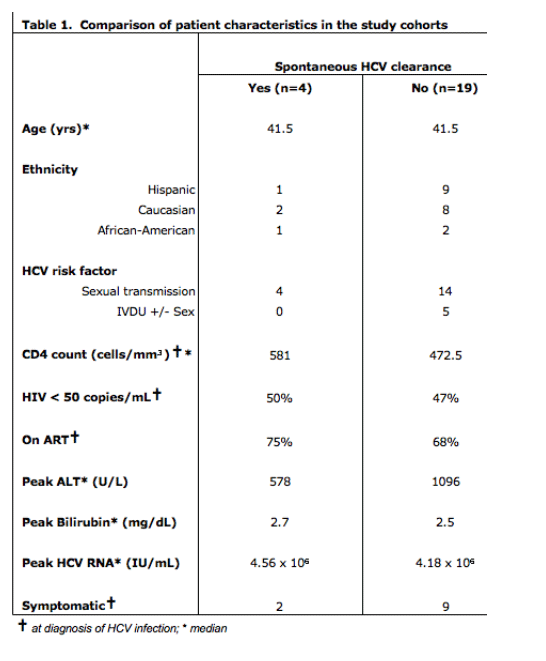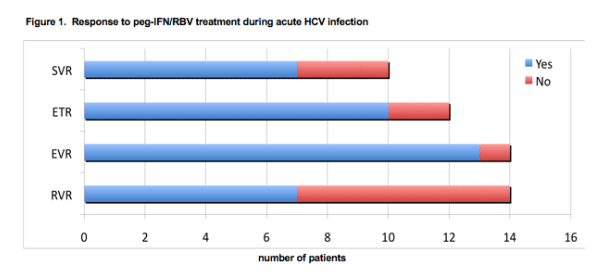 |
 |
 |
| |
An On-going Outbreak of Acute HCV in HIV-infected Men in New York City:
Rates of Spontaneous Clearance, Treatment Responses, and Liver Fibrosis
|
| |
| |
Reported by Jules Levin
ICAAC/IDSA Nov 1 2008 San Francisco, CA
Alison J. Uriel1, Daniel S. Fierer2, Damaris C. Carriero1, Douglas T. Dieterich1, Michael P. Mullen2, M. Isabel Fiel3, Swan N. Thung3, Stephanie Factor2, Sarah Fishman1, Arielle Klepper1, and Andrea Branch1
1 Division of Liver Diseases, 2 Division of Infectious Diseases, and 3 Department of Pathology, Mount Sinai School of Medicine, New York, NY 10029 USA
"Moderately advanced liver fibrosis was seen during the acute phase and in the early chronic phase in almost every patient evaluated suggesting far more rapid fibrosis progression than previously reported in patients with HIV infection, even in those who eventually had spontaneous clearance. It is therefore crucial to detect and treat acute HCV infections during the acute phase to take advantage of the higher cure rate (70%) and prevent further progression of the already moderately advanced liver disease. We therefore recommend that HIV-infected MSM be considered a risk group for HCV infection and that at least yearly screening for HCV antibody be performed in a addition to quarterly surveillance of LFTs. The occurrence of a second episode of acute HCV in one patient underscores the need to better educate these patients about the risks as well.".... "Spontaneous clearance was seen in 17% of the episodes of acute HCV in HIV-infected MSM and was not associated with sexual exposure as the risk factor for HCV."
BACKGROUND
We have identified an outbreak of acute hepatitis C infection in New York City and have recently described the presence of moderately advanced liver fibrosis during the acute phase of HCV infection in these patients. Our preliminary findings also suggest that these infections were sexually transmitted, and recent literature suggests that sexual exposure is associated with increased spontaneous clearance rates.
AIMS
To determine the rate of spontaneous HCV clearance, treatment responses with pegylated interferon (peg-IFN) and ribavirin (RBV), and examine the liver histopathology in a prospectively enrolled cohort of HIV-infected men who have sex with men (MSM) with acute HCV infection in New York City.
METHODS
Data were collected on 22 patients (23 episodes) consecutively enrolled between January 2005 and April 2008. Acute HCV infection was diagnosed using a combination of new marked ALT elevation; HCV seroconversion; and > 1 log10 fluctuation of HCV RNA. Spontaneous clearance was defined as HCV RNA persistently < 5 IU/ml for at least 24 weeks without treatment. Patients with detectable HCV RNA after an observation period of up to 24 weeks were offered treatment with peg-IFN/RBV. RVR, EVR, and SVR were defined as HCV <600 IU/ml after 4 weeks and 12 weeks of peg-IFN/RBV, and 24 weeks post-therapy, respectively. Liver biopsy was offered to all patients during the observation period prior to undergoing therapy. Fibrosis stage was determined using the criteria of Scheuer (scale 0 to 4). Clinical variables including age, ethnicity, HCV risk factors, anti-retroviral therapy, CD4 count, and HIV viral load at diagnosis; peak bilirubin, ALT, and HCV RNA; and symptomatic versus asymptomatic presentation were compared between patients with and without spontaneous clearance using Students t and Fishers exact tests.
RESULTS
Median age was 41.5 (29 -49) years, 45% were Caucasian, 41% Hispanic and 14% African American.
All had HCV genotype 1.
Median CD4 count was 499 (223-969) cells/mm3; 70% were on anti-retrovirals; 43% had detectable HIV viral load.
HCV exposure was via high risk sexual activity alone in 18/23 (78%) episodes and IDU + sexual exposure in 5; 11/23 (48%) episodes were symptomatic.
Spontaneous clearance occurred in 4/23 episodes (17%).
Peg-IFN/RBV was started in 16 patients, 3 have been lost to follow up, one of whom had an end of treatment response (ETR); two patients are still on treatment and one patient is in post-treatment follow-up. RVR occurred in 7/14 (50%); EVR in 13/14 (93%) and SVR in 7/10 (70%) evaluable patients completing treatment.
There were no early discontinuations due to adverse events (Figure 1). There were no significant differences with respect to clinical or virological factors between patients with and without spontaneous clearance (Table 1), although there was a trend toward higher peak ALT levels in patients who failed to clear spontaneously (p = 0.165). One patient with genotype 1b HCV who achieved SVR became newly infected with a genotype 1a infection following a relapse into IDU.
Fourteen patients underwent liver biopsy a median of 4.3 months after first noted ALT increase (range 0.6 to 18.1 months). Twelve (86%) had stage 2 (of 4) fibrosis, 1 had stage 1 fibrosis, and 1 had stage 0 fibrosis (Figure 2). Three of 4 patients who ultimately had spontaneous clearance underwent biopsy and all had stage 2 fibrosis. There were no correlations between treatment outcomes or spontaneous clearance and degree of fibrosis.


Figure 2. Histopathology, needle liver biopsy
Patient had documented seroconversion 3 months after prior negative test, a peak ALT of 1,096 U/L, and HCV VL fluctuation of 2.0 log10 IU in 3 wk; he had never received ART. Biopsy performed eight weeks after onset of hepatitis; diagnosis: stage 2 fibrosis and grade 3 necroinflammatory changes.

CONCLUSIONS
Spontaneous clearance was seen in 17% of the episodes of acute HCV in HIV-infected MSM and was not associated with sexual exposure as the risk factor for HCV. SVR with peg-IFN/RBV was achieved in 70%, significantly higher than HIV-infected patients with chronic HCV infection but significantly lower than in patients with acute HCV without HIV infection. Moderately advanced liver fibrosis was seen during the acute phase and in the early chronic phase in almost every patient evaluated suggesting far more rapid fibrosis progression than previously reported in patients with HIV infection, even in those who eventually had spontaneous clearance. It is therefore crucial to detect and treat acute HCV infections during the acute phase to take advantage of the higher cure rate and prevent further progression of the already moderately advanced liver disease. We therefore recommend that HIV-infected MSM be considered a risk group for HCV infection and that at least yearly screening for HCV antibody be performed in a addition to quarterly surveillance of LFTs. The occurrence of a second episode of acute HCV in one patient underscores the need to better educate these patients about the risks as well.
|
| |
|
 |
 |
|
|